
(3) Immediately following the capstan and the capstan pressure roller is another tape guide.
Each tape guide serves to keep the tape in alignment with the heads at all times. If the tape guides
permit any vertical variation of the tape, a possibility exists of attenuation of the recorded signal during
reproduction. In extreme cases the signal could be lost entirely, or the erase head would either fail to
erase or improperly erase when a recording is made. The tension idler near the takeup reel serves the
same purpose as the other tension idler. The torque on the takeup reel changes according to the amount
of tape on the reel.
b. Three tape heads may be used on the more expensive tape machines. Some machines, such
as those designed for home use, use the same head for recording and reproducing.
(1) The basic construction of tape heads is the same--that is, the head consists of a core of
permeable material which is wound with a coil of wire (fig 3-2). This core of permeable material is
formed into a contact. The core material is usually of a laminated construction (fig 3-3) rather than
nonlaminated. The nonlaminated heads are cheaper to construct, but they usually produce poor results.
The laminations, produce a better response to higher frequencies by reducing magnetic losses due to
eddy currents.
(2) The core of the head is wound with a number of turns of wire, but the number of turns
depends upon the purpose for which the head is designed. The manner in which the core is wound is
dictated by the head use; also, two windings may be used. Most of the newer heads follow the two-
winding design, one winding on each side of the gap. In most of the newer designs, the two windings
are terminated externally, thus they may be connected in a parallel or series arrangement as desired. The
core and winding are enclosed in a protective metal housing to prevent the winding from picking up
hum emanating from motors, transformers, etc.
Figure 3-2. Construction of magnetic head
25



 Previous Page
Previous Page
